Von Chris Grinter, on July 1st, 2010 And now for the even more infrequently reoccurring series, vox populi! For those without scarring high school memories of latin class (through no fault of my teacher) I’ll bring you up to speed – the title roughly translates to “voice of the people”. Here is another old e-mail that I’ve been saving. It is a 100% real message, but of course I have redacted the real names and addresses to protect the innocent. Enjoy! I also highly encourage submissions of your own-
Winter 2008:
“Hallo, I’m so glad I found you. Jetzt, I hope you can help me. 1982, while camping at an old gold mining camp in the Mendocino National Forest I was bitten by a large brown spider. It took three days for the venom to pass through my system. On day three I was 95% blind, the bite swelled to a large grotesquely deep red bump on my arm. I’ll never forget the 12 hours the venom attacked me. The price I payed to survive this spiders venom was…….to loose absolutely all my body fat. I spoke with a doctor from Santa Rosa by phone from a friends place in (some small CA town). He knew about this spider and couldn’t believe I suvived the venom when I told him I lost all my body fat. He also told me it was impossible for someone to survive loosing all their body fat in 12 Std. I reminded him that this was an impossible situation. He told me that this spider is being kept from the public. I believe this spider came from China or Russia. These spiders don’t share anything with other Cali spiders. They have big bodies and short stout legs. The female that bit me was about 4 inch’s and, had 5 males. Four years later, while living in the Hayward hills, I couldn’t believe my eyes, running across the floor, another one. This spider was about 6 inch’s. I know these spiders don’t climb walls or spin webs. They build nest’s, and obtain 4-5 males to protect her and find food. The female never leave’s the nest except…………when a larger female drives her out and, kills her males. This is when people are bitten by this spider, as she runs around looking for another nest. Bites are very uncommon. I wondered………….how big was the female that drove that 6 inch from her nest. Und………….how big do they get. Can I find this spider on display at (your museum)? Is it possible to find all the information their is on this very dangerous spider?”
Continue reading Vox Populi, volume II
Von Chris Grinter, on June 26th, 2010 Welcome to volume eight of the inconsistently reoccurring series, Genie der Presse. Stieß ich auf Dieser Beitrag recently regarding an endemic Puerto Rican butterfly. Who can tell me exactly why this report is misleading? It may be a little trickier than the standard GOP (I suggest discarding any previously associated acronyms with those letters). Hint, just telling me the butterfly in the picture is from Malaysia is not the answer I’m looking for!
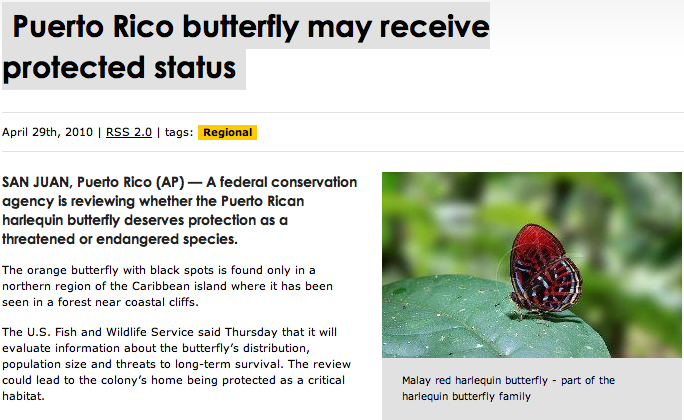
Von Chris Grinter, on June 23rd, 2010 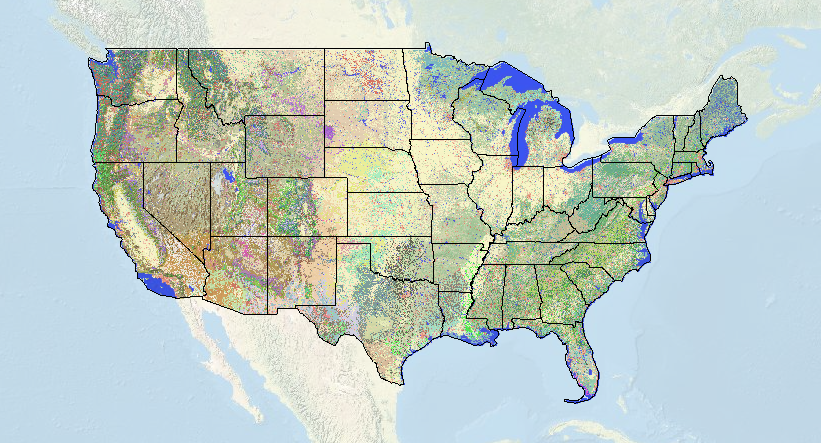
I’ve always wondered how to find the correct terminology for land cover in a given area. Usually, I just ballpark something along the lines of “oak chaparral”. But now I can use this awesome new map brought to us by the USGS/National Biological Information Infrastructure. The level of detail is amazing, and you can specify the degree of accuracy with a drop down tab (1-3). Now with a high-def US topo map I can see exactly where the largest stands of monterrey pine are (actually it’s a California Coastal Closed-Cone Conifer Forest and Woodland) so I can optimally place my trap this weekend.
Continue reading Landscape Cover Map
Von Chris Grinter, on June 18th, 2010 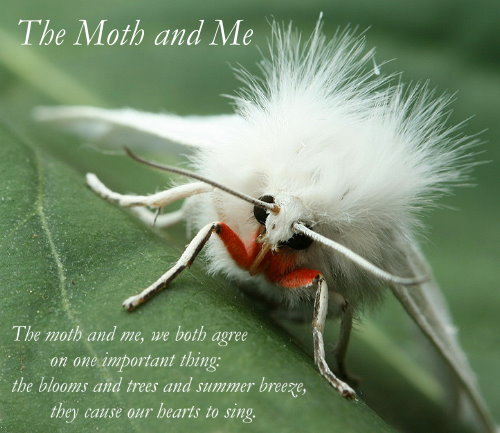
Welcome to The Moth and Me #12, and my first blog carnival. Despite blogging for a few months I have yet to take a look back and reflect on exactly how I became enamored with lepidoptera in the first place. Remembering a time or location where this happened is impossible, and like many of my colleagues and I’m sure many of my readers, I had a butterfly net and “bug cage” in hand as soon as I could walk. When it comes to entomology I believe almost everyone falls in love at first with a large and striking insect. For me it was a butterfly, naturally. I can remember staring for endless hours at the diversity of Ornithoptera and Papilio illustrated in Paul Smart’s famous book. Somewhere along the way in pursuit of something new I began to stray into the nocturnal world. Moths comprise the majority of the diversity of Lepidoptera; while there are nearly 11,000 species in the United States, only a few hundred are butterflies. This quickly opened a door (maybe into an abyss…) to the shocking abundance found everywhere around us. This amazing diversity has now drawn me deep into the biology and evolutionary history of the Lepidoptera. Editing these fourteen contributions of moth blogging together I just can’t help but to reflect back on some of my own mothing journey.

Perhaps if I was a child in Europe this moth (Deilephila elpenor porcellus) would have been the first to catch my eye. Over at Urban Moths Ron Laughton has discovered the stunning diversity in his own back yard in much the same way as I did growing up here in the US. Take a look at the types of traps he has been using, most of which he constructed himself. One of the best behaviors of moths is their willingness to dive headlong into the light. Not too far from Ron, Mike Beale has been blogging british moths as well. It can be pretty amazing just how similar our two faunas are (a few moths actually are the same).
Continue reading The Moth and Me #12
Von Chris Grinter, on June 11th, 2010 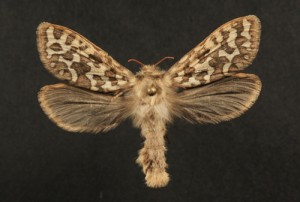
Diese Motte ist genauso selten wie ihr paranormaler Namensvetter (außer dass es echt ist) – es ist ein Gazoryctra sp. in der Familie Hepialidae. Sie stellen eine Grundlinie der Lepidoptera dar und werden allgemein als Geistermotten oder Schnellmotten bezeichnet. Geist – weil bekannt ist, dass Männchen einiger Arten in echten Leks fliegen, wo sie in der Dämmerung auf grasbewachsenen Lichtungen auf und ab schweben, während die Weibchen beobachten. Dieselben Männchen rufen auch Weibchen mit Pheromonen an, Eine etwas rückständige Situation mit Insekten. Schnell- eher selbstverständlich, Es ist jedoch bekannt, dass boreale Arten starke Flieger sind.
Eines der Merkmale, die darauf hinweisen, dass es sich hierbei um eine Basallinie handelt, ist die Platzierung der Flügel am Körper, etwas Flügeladerung, reduzierte oder fehlende Mundwerkzeuge und das Fehlen einer starken Flügelkopplungsvorrichtung. Diese Motten haben eine “Joch”, Dabei handelt es sich um einen kleinen daumenähnlichen Vorsprung von der Oberseite des Hinterflügels. Andere Mottenlinien haben einen engen Kopplungsmechanismus, der als Frenulum und Retinaculum bekannt ist, wo Borsten die beiden Flügel miteinander verhaken, so dass sie während des Fluges gekoppelt bleiben. Im Ruhezustand faltet sich das Jugum und hilft wahrscheinlich dabei, die Flügel zusammenzuhalten – aber nicht während des Fluges; Der Vorderflügel ist nicht synchron zum Hinterflügel und der Flug ist nicht dynamisch (Scoble 1992).
In Amerika ist die Biologie der Hepialiden nur sehr unzureichend verstanden. Weltweit werden nur eine Handvoll Lebensgeschichten beschrieben – alle scheinen endophagös zu sein (langweilig) in Pflanzenwurzelsystemen. Einige Larven im frühen Stadium fressen möglicherweise in der Laubstreu oder unter der Erde am Wurzelsystem, bevor sie in das Rhizom eindringen. Australien hat das Glück, über eine vielfältige und beeindruckende Hepialidae-Fauna zu verfügen – viele sind brillant gefärbt und enorm (250mm oder bis zu 12 Zoll!), und etwas besser studiert. Einige Larven kommen sogar so häufig vor, dass Ureinwohnerstämme sie als Grundnahrungsquelle genutzt haben.
Aber zurück zu dieser Motte im Besonderen. Ich habe es letzten August in meiner Schwarzlichtfalle oben in der Sierra Nevada gesammelt 10,500 Füße. Die Art ist unbekannt, und dürfte wahrscheinlich neu sein. Das Frustrierendste daran ist, dass es das einzige Exemplar ist, das der Wissenschaft bekannt ist. Die gesamte Gattung ist sehr selten, mit Ausnahme einer oder zwei häufiger vorkommender Arten, Es existieren nur wenige Dutzend Exemplare. Es handelt sich also um ein Weibchen einer Art, die nur aus einem Männchen besteht? Eine seltsame Abweichung einer ansonsten bekannten Spezies? Oder vielleicht ist es tatsächlich neu. Ich habe die DNA mit einem Barcode versehen, Das sagt mir eigentlich nichts, da es keine Sequenzen von eng verwandten Arten gibt. Tatsächlich, soweit ich weiß, Die anderen Arten in der Sierra wurden seit Jahrzehnten nicht einmal mehr gesammelt, sodass ich nicht einmal eine Sequenz von einem älteren Exemplar erhalten kann. Das Tüpfelchen auf dem i ist ihr Verhalten. Sie selten, wenn überhaupt,, ans Licht kommen – was möglicherweise auf ihren dämmerungsbedingten Flug zurückzuführen ist. In der richtigen Nacht sind sie vielleicht auf dem Vormarsch 20-30 Protokoll, Normalerweise sucht eine Frau nach einem Mann, oder ein Weibchen, das zur Eiablage fliegt (Wahrscheinlich streuen sie ihre Eier einfach auf den Boden). Also werde ich Ende August mit ein paar Freiwilligen aus der Abteilung für Entomologie in die hohe Sierra zurückkehren, in der Hoffnung, einen von ihnen an den steilen Hängen an mir vorbeifliegen zu sehen. Wenn ich noch welche bekomme, Es könnte sich herausstellen, dass es sich um beeindruckende neue Arten für Kalifornien handelt.
Von Chris Grinter, on June 11th, 2010 Wer kann sehen, was falsch ist Dieser Beitrag?

Von Chris Grinter, on June 9th, 2010 
Dies recent article in the American Naturalist has taken a second look at some of the famously inflated species estimates, some going high as 100 million (Erwin, 1988). Estimates conducted by the authors indicate that projections above 30 million have probabilities of <0.00001. Their estimated range is more likely to be between 2.5 und 3.7 million species (with 90% confidence). This seems somewhat reasonable given that these extraordinary estimates were based heavily on extrapolation. There are clearly many difficulties in assessing diversity based on tropical arthropod surveys – this paper again uses phytophagous (plant-eating) beetles for estimates. They are careful to point out that these methods do not account for non-phytophagous insects, but assume that they will follow traditional biogeographic patterns of diversity. This is somewhat of a new concept given that when I was in college I was taught that parasitoids are counterintuitively not more diverse in tropical regions. This hypothesis is more often than not being proven false in the light of more precise modern taxonomic methodology. Rather proudly I helped play a role with the parasitoid project at the UIUC. Kurzum, host specificity is more extreme in tropical environments with hundreds of cryptic species hidden amongst rapidly radiating groups such as the microgastrine Braconids (Hymenoptera) – the same has held true across similar taxa.
One interesting note about the paper is their inclusion of a secondary estimation based on Lepidoptera canopy assemblages. They assumed that a) all Lepidoptera can be found in the canopy and b) that all leps are phytophagous. This is clearly a very conservative estimation given that not all Lepidoptera are found in the canopy and not all are phytophagous. While I do not have the numbers on hand, a certain percentage of lep diversity must have been excluded from these estimates. I will also go out on a limb and assume that the authors (Novotny 2002) did not include microlepidoptera morphospecies – and most likely estimated abundances with our current taxonomic understanding. However I do not have access to this 2002 paper, so I may be incorrect. Using these Lepidoptera numbers (from the same survey as the Coleoptera) a global diversity was estimated by Hamilton et. al. at around 8.5 millions arthropod species.
While I agree that extraordinary estimates of tens of tens (or hundreds) of millions of arthropod species are probably ridiculous; I am of the camp that current research is indicating that estimates of the lower tens of millions of species are possible. The authors have failed to include research that counterbalances their premise that tropical species exhibit a lower beta diversity (Novotny 2002, 2007). In the same journal, Natur 2007, Dyar et. al. have indicated that the American tropics exhibit a higher beta diversity than previously assumed. Either it can be said that estimates of beta diversity in the australasian tropics are incorrect, or they are incompatible with species assemblages of neotropical forests. All of this speaks to the difficulty in extrapolating estimations of species across all tropical regions. These estimates are based on comprehensive insect surveys of New Guinea, perhaps they do not accurately reflect the true diversity of American tropical forests, and these number ranges are low.
As a final thought, most assesments are focused on tropical arthropods. It seems all too possible that the total number of all species, including bacteria and archaea, can easily exceed tens of millions. But extrapolating those numbers is even more precarious than arthropods, given the extreme lack of knowledge we have.
Von Chris Grinter, am 4. Juni, 2010 
Einen Weg, um die direkte Video verlinken nicht finden (nicht einmal Vodpod), but here is the link to the Daily Show site. Wie viele Physiker zog sich die Haare, wenn sie dieses hörte man? Huch, er ist der neu ernannte Sprecher. Don’t worry Neil, Sie nicht überall nach diesem gehen.
Having not aired yet I can’t tell exactly how apologetic the show is, but it seems heavily focused on finding the “creator”. I can hear it in John Stewart’s voice when he pulls back from ripping into Freeman’s “god of the gaps” theory. Perhaps there was an edit and we missed the question where John Stewart asked “Morgan, can you define a logical fallacy for us… perhaps the god of the gaps one?” I believe that any physicist who ever says “god was responsible” says it with no deeper meaning than when Einstein famously evoked god’s dice. That’s to say, a non-literal and non-personal god found only in the beauty and splendor of nature.
Von Chris Grinter, am 2. Juni, 2010 
Wenn es eine Sache gibt, die ich in der Schule gelernt,, es war, wie man leicht ablenken mich. Ich neige dazu, meine TV im Hintergrund zu halten, während ich auf meinem Computer arbeiten, vor allem spät in der Nacht, wenn ich in der Regel im Kampf mit einem Gewinn Krieg gegen den Schlaf. The other night something did catch my eye: a man holding dowsing rods in his back yard. Volume up, let the bullshit flow. It was just a flash of idiocy in an otherwise good program on home improvement. I’ve become accustom to crap-based TV on networks such as the History Channel or a Discovery network (quality of their shows include gems like “The Haunted: ghosts and pets”), but I was a little surprised to see BS grace my local PBS station.
Over on the “American Woodshop” host Scott Phillips was constructing a beautiful garden arbor. You can watch the entire thing here for free: Episode 1609: Period Architectural Moldings and Trim. There are no time stamps on the clip, but the dowsing comes in around the mid-point. While demonstrating the materials needed to secure the wood to the ground he cautioned against digging haphazardly into your yard without knowing where the underground water, electrical or gas lines were: solid advice. So in order to do this you should (paraphrasiert) “take pieces of coat-hanger, anything will do, turn them into an “Die”. As I walk forward the bars cross – there (they cross) – right there is the irrigation line. 9 out of 10 people have this ability, but you should call in a professional if there is any doubt“. My translation “OK guys, don’t worry about calling in some guy to do this, figure it out this way”. Please tell me what man who seriously watches a home improvement show at midnight would cede authority to someone else before giving it the good ol’ college try? Even if we grant for a moment that 9 out of 10 people could do this, what about that one guy who can’t? Isn’t it irresponsible to suggest that you can avoid power/water/sewer/gas only 90% Es ist immer schön, eine Geschichte wie diese zu sehen, denn so laufen die Dinge normalerweise sicherlich nicht ab? Oops, hit that pesky gas line…
Being a scientist, a skeptic and a procrastinator – I wrote Scott a message about this so I could avoid my work at hand. Today he kindly replied saying: (excerpt)
“Our bodies are electromagnetic fields. Disrupt a field and things happen…. I learned the technique mentioned from a city worker that they used to find lines. Not from a charlatan. My team witnessed the objective use of this technique.”
Briefly, no, our bodies are not electromagnets. Everyone can hold a compass, or TV… without screwing them up. Franz Mesmer coined the idea of “Animal Magnetism” in the last half of the 18th century (also invented “mesmerization” AKA hypnotism) – and had it abruptly debunked by Benjamin Franklin and others. I’m also a bit worried to hear that city workers are relying on dowsing to locate public lines! But to move onward, let us dig into the myths of dowsing. I agree that there seems to be somewhat of an intuitive truth when it comes to dowsing, however false it is scientifically, it remains compelling. Sicher… electrical things underground effect sensitive wires above. And wow, look at all these guys who can find water, or power, oder… lost people… oder bombs? Ok, let’s stick to water for this conversation.
(continued)
Continue reading An Uphill Battle
Von Chris Grinter, am 1. Juni, 2010 Just a few images of common California leps, taken along the coast range near Santa Cruz a few weeks ago. Starting to work my way through some photo backlog…

Euphydryas chalcedona
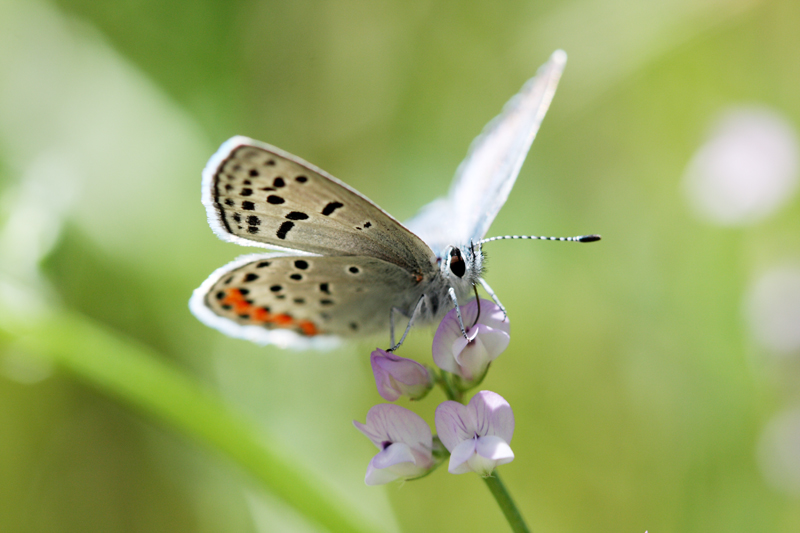
Plebejus acmon
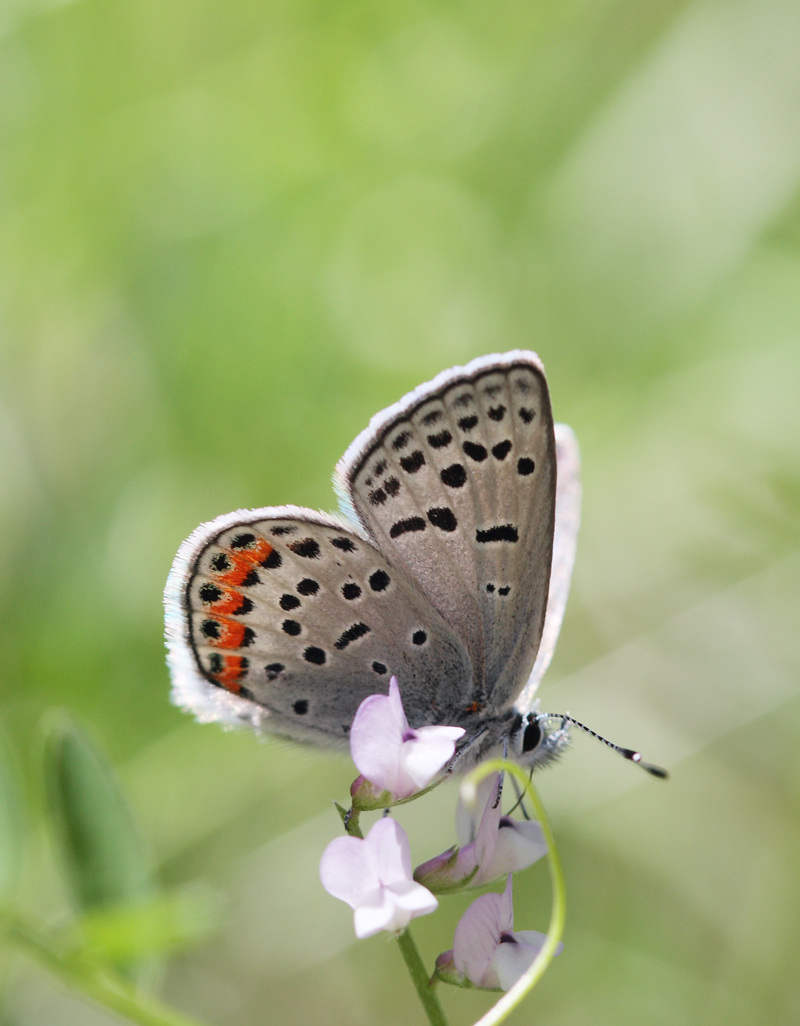
Plebejus acmon

Ethmia arctostaphylella An Eriodictyon sp.
One interesting note on Ethmia arctostaphylella – the name is a misnomer, it does not actually feed on Arctostaphylos (Manzanita). At the time of description in 1880 Walsingham had found larvae pupating on leaves of manzinata and assumed it was their host plant. In Jerry Powell’s stunning monograph of the group he indicates this moth was reared from Eriodictyon – which happens to be the flower the moth is perched on. The two plants grow side by side, and it’s pretty easy to see how a wandering caterpillar finds its way onto a neighbor.
|
Skepsis
|













